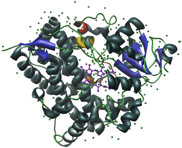


|

|
||||||||||||||||||
| Home | P450s | UGTs | BGLUs | cyt b5 and P450 Reduc | Gallery | BLAST | Search | Publications | Links | ||||||||||
| Chromosome Maps | Alignments | Trees | Logos | P450 Reductases | Sequences | P450 Lists | Intron Maps | P450 ESTs | Acknowledgements |
Cytochrome P450s were first identified in 1958 (Klingenberg 1958 and Garfinkel 1958) from their spectral properties. At this time they have been found in all living organisms, from bacteria to animals and plants. They are involved in a vast array of reactions (eg. hydroxylation, isomerization, epoxydation, N-dealkylation, cyclization) in many different pathways (eg. hormone metabolism, secondary metabolism, biopolymers). They are hemoproteins, and require a Cytochrome P450 Reductase to transfer electrons from NADPH to their substrate. Please see the reaction mechanism below.
In Eukaryotes, P450s are membrane-bound and primarily located in the Endoplasmic Reticulum. They often catalyze a specific reaction on valuable products, and are becoming more and more attractive for biotechnologies. Due to their crucial role in drug metabolism, they are well-studied in humans.
|
Chr 1 Genetic ~ Base Pair |
Chr 2 Genetic ~ Base Pair |
Chr 3 Genetic ~ Base Pair |
Chr 4 Genetic ~ Base Pair |
Chr 5 Genetic ~ Base Pair |
This site is sponsored by: